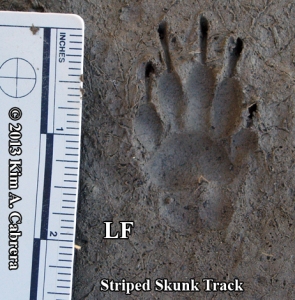A couple of months ago, a skunk moved in under my house. I didn’t actually see it, so how did I know it was a skunk? If you’ve ever smelled skunk spray, it’s not something you forget. The pungent, musky smell hangs in the air for a long time. I had smelled it a couple of times in the early evening, so I knew there was one prowling about.
My two dogs confirmed my suspicion one night when I let them out for their last pee. As soon as I let them out, they ran around the fenced area like crazy, sniffing the ground (clue #1). My littlest dog then went to the lattice enclosure around the bottom of the deck and was obviously very interested in something (clue #2).
The next morning I saw some small animal tracks under the bird feeder (clue #3). Skunks have five toes on each foot, and claws that extend from each toe. The claws make deep tracks on the fore feet, unlike a cat, which retracts its claws. The hind foot leaves the mark of a heel pad that is usually between two and two-and-a-half inches.

striped skunk track – left front foot Fernbridge, CA 1/13/13
Okay, so a skunk had been in the yard last night, probably attracted to the spilled sunflower seeds below the feeder. I began checking to see if there was any place where a small animal could get under the house. A skunk, which is about the size of a small housecat, could squeeze between the lattice framwork around the deck. Then I noticed a depression where a critter had dug to get under the house. So, there was indeed a skunk living under my house.
The negatives to having a skunk living under your house are: 1) they can contract and spread rabies; 2) they can dig burrows or tunnels under there; and 3) if they find an opening, they can get inside your house. Three very good reasons for not having a free-loading skunk as a boarder.
I removed the bird feeder and cleaned up all the spilled seed. At least I wouldn’t be aiding and abetting the intruder. I was trying to figure out how to get the skunk to leave when my dogs took care of the problem for me.
The next night, I let them out and right away smelled the skunk, but it was too late. The dogs lit out after something in the dark. I held my breath, waiting to see what would happen. I was anticipating having to deal with two very stinky dogs, but miraculously, they didn’t get sprayed.
Turns out, the skunk took his leave that night. I made a mental note to close up that opening under the house. Problem solved.

